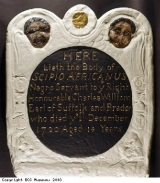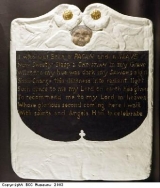The 18th century: church records
Church records are a valuable source of information about the local population. Often they are the only record of the life of a black person in Bristol. Many are only known because they were married in church, or had their children baptised. Mary Columbus and Joseph Thomas, are described in the St Stephen’s Church marriage register as ‘A negro’ and ‘a negress’ from Jamaica in the Caribbean. They worked as servants for a merchant called Heathcote who lived in St. Stephen’s parish. They were married in Bristol in 1702. Pictured here is a 1673 drawing of St Stephen’s Church where the two servants married.
A black couple, ‘a pastry maker’ called Commodore and Venus, were married at St. Michael’s Church, Bristol, in 1721. Commodore may have been a free man, but there is not way of telling this from the church records.
William Rice and Rebecca Neale were married in the church of St. Augustine the Less (next to Bristol Cathedral) in September 1728. They are described in the church register as ‘Blacks’. Their four daughters, Mary, Betty, Susannah and Mary, were baptised in the same church. The daughters’ baptism records do not mention their colour. Shown here is a drawing of St Augustine’s Church, made in 1673, where the Neale couple were married and their family baptised.
The burial register of St Augustine’s Church records two burials, of Captain Caster’s ‘black man’ in 1766 and Captain Harwood’s ‘black boy’ in 1770. Captains of slave ships often had a black slave as a personal servant. They would have ended their days in Bristol, having been bought by the ship’s captain in Africa or the Caribbean and brought back as a personal servant.
In 1778, a 12 year old black boy known as Ned was buried in the graveyard of the old church of Quakers Friars in Bristol. He was a servant to a friend of the local Champion family. The Champions were Quakers , and were involved in the trade with the Caribbean and the local pottery industry.
Sometimes it is a gravestone that records the life of a black resident of Bristol. The most well-known is that of Scipio Africanus, in Henbury churchyard, just outside Bristol. Scipio Africanus, whose real name we do not know, was servant to Charles William, Earl of Suffolk and Bindon, who married one of the Astry family of Henbury House. The black servant was named after an ancient Roman general of African origin, Scipio Africanus. The nick-name contrasts the servant’s lowly position as a slave with the status of the high-ranking Roman general of the same name. Scipio Africanus died in December 1720 at the age of 18. Little more is known about him. He might have been with the Earl for many years or only a few, we don’t know how long he had been in Henbury. There is no record in the church registers of his burial, although he has one of the most ornate graves in the churchyard. Pictured here are the headstone and footstone for his grave. The footstone reads:
I who was Born a PAGAN and a SLAVE
Now Sweetly Sleep a CHRISTIAN in my Grave
What tho my hue was dark my SAVIORS sight
Shall Change this darkness into radiant light
Such grace to me my Lord on earth has given
To recommend me to my Lord in heaven
Whose glorious second coming here I wait
With saints and Angels Him to celebrate
The verse on the stone at Scipio’s feet refers to him becoming a Christian and the benefits of this Christian belief. Scipio Africanus’s tombstone still stands in the Henbury Churchyard, near Bristol.




